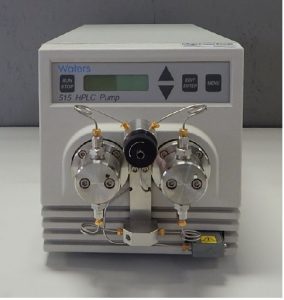HPLC pumps from the basic part of HPLC instrumentation.
Unlike other chromatography techniques, HPLC needs to generate pressure by pumps.
Without a proper pump, HPLC analysis is impossible and the instrument is not operable.
As the name, HPLC i.e. high-performance liquid chromatography indicates, one needs to generate pressure.
HPLC pumps generate pressure on the solvent so as to pass through the dense column.
Since the column particles are very small, the surface area is high and even separation is efficient.
But the pressure required for the mobile phase to flow is very high. So pumps able to generate such high pressure are needed in HPLC.
In general, the operable pressures in HPLC are 500 to 5000psi.
In UPLC, which is Ultra pressure liquid chromatography the pressure might go up to 10,000psi or even more.
So the HPLC pumps must be tough to generate such high pressures.
As a general rule, HPLC pumps used should suffice some requirements like
a) Generate sufficient pressure generation through the column,
b) Suitability to the wide range of solvents used,
c) create uniform pressure without fluctuations
d) deliver constant flow rate i.e. the volume of solvent pumped per minute
d) easy to use and operable for a long duration
e) Less cumbersome and smaller in size to fit the instrument.
f) also preferably inexpensive.
Based on these requirements of HPLC pumps, there are of three types like
- Screw-driven syringe pump
- Reciprocating pumps and
- Pneumatic pumps.
Syringe type HPLC pump:

This pump works by producing a pulse-less delivery. And by this, the flow rate of the mobile phase is very well controlled. They are suitable for the isocratic mobile phase HPLC run. isocratic means using the same mobile phase or single solvent throughout the run.
They have their limitations like small injection volume. Also one cannot use them to run gradient mobile phases i.e. multiple mobile phases as a mixture in a single run.
Reciprocating pump (piston pump):
As the name indicates, the pump has two or more pistons. This is the most common and widely used pump. Here the mobile phase is pushed due to the back and forth action of pistons present about a cylindrical chamber.
It is widely used due to the following reasons.
- Good pressure generation.
- Constant flow rate.
- Useful for both gradient and isocratic runs.
- Space occupancy is low.
The pneumatic pump is another simplest pump. As the name indicates (pneumatic) there is the use of gas to pressurize the mobile phase present in a collapsible solvent container. They have some advantages like low-cost or inexpensive to purchase, pulse-free, and also simple.
But are not widely used due to disadvantages like low-pressure generation, low capacity to dispel the mobile phase, and also the pumping rate varies with the viscosity of the mobile phase used.
Reciprocating pumps are used in most of the instruments. They are used as a single pump or dual or multiple pumps to meet the needs of the analysis like isocratic or gradient elution etc. They are present in most advanced instruments so they are controlled by software. The pressure, rate of flow of mobile by the pump are regulated by software making it hassle-free.
Even though the pumps generate sufficient pressure, due to air bubbles the pressure might drop and fluctuate. So the HPLC mobile phase should be free from gas bubbles.